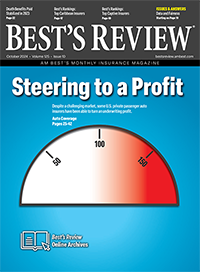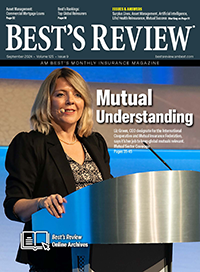Emerging Risks
D&O Writers Brace for Wave of Costly Diversity Lawsuits
Shareholder derivative lawsuits that target boards’ failures to act on diversity goals could steam roll directors and officers lines of business.
- Renee Kiriluk-Hill
- April 2021
-





The Emerging Risks Special Section is sponsored by Finys. Click on the microphone icon to listen to the Finys podcast.
Key Points
- What’s Happening: Costly shareholder derivative lawsuits charging boards of directors with failing to diversify have been filed against major companies and could become a megatrend.
- Perspective: Observers compare the diversity awareness trend to the earlier #MeToo movement against sexual abuse and sexual harassment.
- What to Expect: D&O insurers will take a more active role by asking their insureds diversity questions that previously weren’t part of their underwriting considerations.
An already stressed directors and officers line is facing even more challenges as the Black Lives Matter movement that gained steam in the summer of 2020 spurs a spate of diversity lawsuits.
Costly shareholder derivative lawsuits charging boards of directors with failing to diversify have been filed against major companies and could become a megatrend, according to observers.
Diversity now factors into a carrier's ultimate decision to provide coverage or walk away, said Sarah Downey, Marsh/JLT Specialty D&O liability product leader. “I don't know if it will play out into rate; rates are already very high for a number of reasons.”
D&O pricing for public companies rose more than 50% in the third quarter, Downey noted, and more than 90% of Marsh clients renewed at higher rates. Coverage is narrowing in the United States and London markets, reducing limits and increasing deductibles, and the situation isn't likely to improve anytime soon, she said.
Public companies have been hit with hundreds of securities suits over each of the past four years. The pricier derivative suits are becoming more frequent, and they're increasingly seeking compensatory damages—not just attorneys fees and governance changes, Downey added.
Observers compare the diversity awareness trend to the earlier #MeToo movement against sexual abuse and sexual harassment.
Regardless of the impetus, racial and gender diversity is a vital topic, “top of mind this year for many people, especially in the corporate world,” Downey said.
It's a difficult factor to underwrite. “I don't expect D&O insurers will tell potential insureds what they need to do with their own board. They will ask diversity questions that I don't think were previously asked … taking more of an active role.”

When it comes to diversity, corporations should realize that staying still is not an option, and so the best way forward for them is to manage diversity and inclusion proactively. Diverse corporations perform better and are well-integrated with their environment.
Sridhar Manyem
AM Best
Diversity a Top Three Concern
Diversity lawsuits are a potential megatrend, Goldberg Segalla partner Eric Fitzgerald said, calling them a top three concern for D&O insurers this year, alongside climate and the COVID-19 pandemic.
The lawsuits may target corporate inaction, but businesses that pledged commitments to diversity are particularly vulnerable if they don't follow through with appropriate action, Fitzgerald added.
A shareholder derivative suit filed against Facebook includes quotes from the social media giant's founder, Chairman and Chief Executive Officer Mark Zuckerberg, about caring “deeply about diversity,” and the company's 2020 proxy statement, “We have an obligation to build a culture of inclusion where everyone can thrive.”
However, the complaint charges, Facebook's approach to diversity has been “characterized by tokenism: Make a small gesture to satisfy appearances, but don't make any underlying substantial change. The message at Facebook is set at the top—by Zuckerberg” and other board members. It claims the company's directors have also “long failed” to curb hate speech posts targeting Black people and minorities. “Platitudes in proxy statements are not progress,” it said.
Observers noted a string of corporations face similar shareholders derivative lawsuits, including Oracle, Qualcomm, The Gap and Cisco.
The Gap lawsuit alleges that certain directors and officers “breached fiduciary duties and benefited from unjust enrichment, among other allegations,” said Sridhar Manyem, AM Best director of industry research and analytics. And the number of suits could grow “significantly,” subsequent to California's enaction of a bill requiring public companies headquartered there to have a minimum of one director from an underrepresented community by 2021, while a company with nine or more directors must appoint at least three such directors by the end of 2022.
Other states are starting to address the issue, but California's action is the “only one that has some teeth in terms of how they're defining diversity,” said Kimberly Blair, a Wilson Elser partner focused on professional liability, D&O liability, insurance coverage and bad faith matters.
The state defines underrepresented communities as Black, African American, Hispanic, Latino, Asian, Pacific Islander, Native American, Native Hawaiian, Alaska Native, gay, lesbian, bisexual or transgender.
In nearby Washington state, an act took effect last year requiring that at least 25% of public company boards consist of individuals who self-identify as women.
Gender diversity is starting to play an important role in environmental, social and governance issues, said Manyem, who noted institutional investors such as Vanguard are “implementing rules for proxy voting where a board fails to meet diversity expectations.”
Courts hearing corporate diversity lawsuits will look to such moves, Blair said, and insurers should do the same and take a proactive rather than reactive approach to underwriting D&O, even if lawsuits on prior coverage are inevitable.
Preparedness Is Key
Fitzgerald said diversity may not have been a D&O issue five years ago, but now it's coming on fast, and insurers need to be prepared.
Goldberg Segalla partner Al Alikin said courts will define “adequate” diversity in different ways. “As in many regular civil cases, it is specific to the location where you're at. The jury is your community, your peers. Those are the folks determining liability.”
He foresees a tide of such lawsuits. “We're still at the early stages of the reckoning,” Alikin said.
Underwriting and pricing coverage may be complicated, but insurers know their trade. What carriers can't do is anticipate a sudden change in direction, like when environmental general liability written to cover slips and falls “all of a sudden became waves and waves of environmental suits,” he said.
The greatest loss risk rests with companies that, akin to #MeToo liabilities, try to conceal a diversity-related problem. “It's one thing to have something bad happen,” Alikin said, but suppression attempts by leadership or boards expose the company to punitive damages. “People hate you for what you're trying to cover up.”
In his D&O blog, RT ProExec Executive Vice President Kevin LaCroix has written about derivative lawsuits, including one filed in July against computer software company Oracle.
He cited the complaint's assertion that Oracle's board is “one of the few remaining publicly traded companies without a single African American director,” and that directors “repeatedly made gross misrepresentations in the company's public statements by claiming to have a multitude of policies, internal controls and processes designed to ensure diversity both at the management level and the board itself.”
Alikin acknowledges the multiple layers of distributors in the industry but said carriers should enact more robust application processes before they agree to bind a policy.
“Did you ask the right questions in the application process?” he said. “Policyholders obviously want the coverage, but they have an obligation to be truthful when asked a certain question.” An insurer can use the answers to raise a premium, or to ensure they've done due diligence, said Alikin.
Manyem stressed the need for action. “When it comes to diversity, corporations should realize that staying still is not an option, and so the best way forward for them is to manage diversity and inclusion proactively. Diverse corporations perform better and are well-integrated with their environment.”
AM Best Associate Director David Blades in November said D&O market conditions had hardened following “years of depressed rates due to capacity-driven competition that led D&O insurers to suffer growing underwriting losses in the past few years.”




































